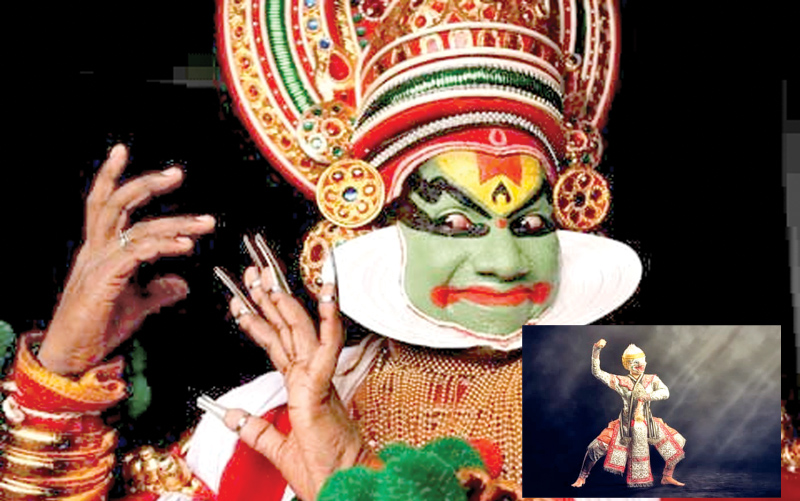Masks play an important role in the classical, folk and ritual dance forms of South Asia and South East Asian countries. In Indian classical dance forms, as well as in the Indian dance dramas, masks play a major role. Along with the full face covered masks, side face masks covering the ears and side of the face, especially designed crowns or kiridams and distinct make-up play a major role in the mask dances.
Among the Indian classical dance forms, Kathakali is the most popular due to its distinct Akariya Abhinaya (makeup and dresses). Because of its distinct makeup, beautifully carved and broad colourful crown or Kiridams and side masks fully covered facial masks or side face masks have added more to the beauty of this dance form. Similarly, Yakshagana, a classical dance form of Karnataka, resembles the Kathakali, mainly in the make-up and in the use of masks.
[SUBHEAD] Ritual dances
Even in some of the folk dances, the masks play an important role. For instance, in Tamil Nadu, popular folk dances such as Therukoothu, Nattukoothu and some other regional folk dances and ritual dances, side masks play an important role. Generally, all the mask dances have some similarities mainly in the stances (standing position), the steps of the dances, as well as in the turns, jumps, twists and various other vigorous movements. In West Bengal, there are two popular mask dances practiced during the Sun Festival.
Gambhira is a Bengali mask dance. But it is essentially a solo dance. Ordinary people believe that there is a magical and religious influence in these dance forms. All these Indian classical mask dance forms are based on the ancient religious and epic themes.
Besides these Indian classical dance forms, in Bharatha Natyam, a new branch of dance concept was developed during the mid-20th century called ‘dance drama’. The theme of the dance and dramas are based on relation. Numerous multi characters are involved in dance drama. Each character has a distinct make-up and dress, to the need and necessity. Sometimes they wear masks. As a drama, dance drama gives more importance to each character’s dress, makeup and the stage décor of the selective scene portrayed.
For instance, in Ramayana dance drama, different characters such as Hanuman, Vaali, Sukirivan, Jaddauyu and Jaampavaan are involved. Each character wears different masks. Ramayana is the most important theme among the Indian and South East Asian dances. In the annual Rama Lila festival, in the North Indian states, the actors or the characters wear masks or semi - masks for their roles.
Dance-based play
In Sri Lanka, numerous mask dances are performed. Some are story based mask dances, others are for amusement. Meanwhile, some masks are used for rituals. The Kolam is considered as a dance-based play. In this dance, a variety of characters are involved. Each character wears a mask for their distinct character. In Kolam, masks are made with appropriate expressions and emotions of each character.
Another important mask dance of South Sri Lanka is Sanniyakuma. There are altogether 18 Sanni demons to cure 18 types of diseases. Each Sanni demon has a particular name and each demon is supposed to heal a particular disease. The dancers representing these demons wear black costumes and a skirt decorated with leaves and wear specific masks.
Masks play an important role in the South East Asian dances. The South East Asian region comprises Vietnam, Cambodia, Laos, Thailand, Java, Sumatra, Indonesia and Bali. Due to the
Indian migration to the South East Asian region for various purposes, this region came under the Indian influence mainly in cultural, linguistic and religious spheres. In Thailand, the themes of the dances are firmly based on Ramayana and Mahabharata.
Classical mask dance
Women, who play an important role in these dances, wear masks, especially for certain roles, like monkeys, demons and devas. Khon, another popular Thai classical mask dance form is based on a series of stories. A variety of characters is involved in these story-based dances. Hence they wear different masks that depict emotional expressions.
In Bali, one of the most popular dance forms is performed in a common place called Barong Rangda. It is a mask dance which reveals the struggle between good and evil. Balinese dance tradition is a fusion of Hindu and Islamic culture. One of the dances is called Wayang Topeng. It is a solo mask dance form which derives its theme from Hindu legends.
Mask dances generally impart various traditional and religious truths. They impact on values of average humans. Sometimes these dances are performed during the festival season for amusement and pleasure. In such mask dances, the comedian or the clown impresses the audience a lot. Some of the mask dances are used for ritual purposes to get rid of evil effects and sickness.



Add new comment